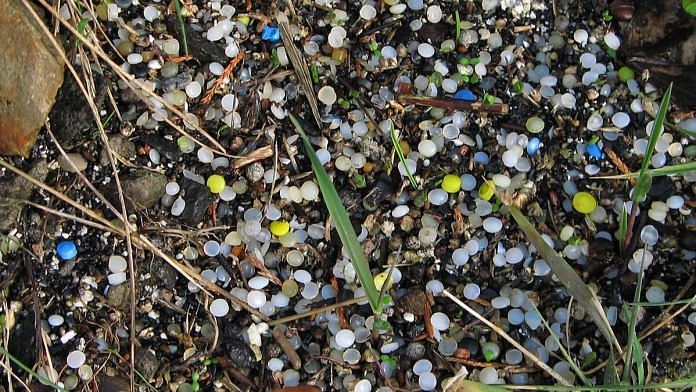Thiruvananthapuram/New Delhi: Days after the Liberian-flagged shipping vessel capsized off the Kerala coast, tiny plastic pellets and other non-degradable remnants from the shipwreck have started washing up on Kerala and Tamil Nadu’s coasts. Experts have raised an alarm over the impact of the spill as state government officials scramble to contain it.
On 24 May, MSC ELSA 3, en route to Kochi, began tilting soon after it left Vizhinjam port, which reports said was because of a technical issue. By the next day, the ship had completely sunk, around 4.6 nautical miles off the Thottappally spillway in Alappuzha.
According to the Kerala government, the vessel carried 643 containers, including 13 with hazardous materials and 12 containing calcium carbide—a chemical known to ignite on contact with water. The vessel also held 84.44 metric tonnes (MT) of diesel and 367.1 MT of furnace oil.
The initial concerns about oil spills and debris drifting along the Indian were soon realised, and the state is still struggling to mitigate the impact.
Around four days later, on 28 May, tiny plastic pellets, or nurdles, began washing up on the Thiruvananthapuram coast. The pellets, which look like hailstones, have now started mixing with the sand.
Apart from plastic nurdles, Sreekala S, chairperson of the Kerala State Pollution Control Board (KSPCB), wood, cloth, paper, glass, and tea bags, all believed to be stock aboard MSC ELSA-3, are also reaching the shores.
Sreekala added that the district administrations, along with the KSPCB and the Disaster Management Authority (DMA), are now working with volunteers to collect debris from Varkala and will be expanding the operations to other coasts as and when more such instances are reported.
“We conducted a drone survey on Thursday to identify the affected areas. Once the collection process is complete, we will decide on the disposal method,” she said.
Furthermore, Sreekala said that though no major oil spill from the ship had been reported, trace amounts of oil have been detected along the Alappuzha coast.
Authorities in Kerala also said that 55 containers have floated ashore so far, reaching Alappuzha, Kollam, and Thiruvananthapuram. Containers have also been spotted as far as the coast of Tamil Nadu’s Nagercoil.
The pellets, which have been identified as the most hazardous items due to their non-degradable nature and potential to harm marine life, have been found predominantly along the Thiruvananthapuram coast, stretching from Varkala in the north to Thumba in the south.
Robert Panipilla, founder of Friend of Marine Life, a civil society organisation that conducts underwater studies, raised concerns over the impact of the capsizing.
“The government isn’t sharing information about what exactly sank with the ship. We depend on marine life, and we have the right to know.”
Impact on marine life & concern about livelihood
On Wednesday morning, D. Christhudas, a 52-year-old fisherman, woke up to a disturbing sight—plastic pellets and cashews had washed ashore in his locality of Adimalathura, Thiruvananthapuram.
While he informed the local police station, the tehsildar only visited the village for inspections Thursday.
Christhudas has not been able to work since.
“Not just here—eight nearby coastal villages are facing the same issue. And the authorities haven’t taken any action since yesterday (Thursday),” Christhudas told ThePrint Friday.
Now, a deeper fear looms—the loss of livelihood.
Experts are also worried about the long-term implications of the incident.
According to Panipilla, if the plastic remains in the sea for long, biomass will start attaching to it. Eventually, marine life will consume it.
“These pellets resemble fish eggs, which can deceive marine organisms,” he said.
Balakrishnan Nair, director of the Indian National Centre for Ocean Information Services (INCOIS), also echoed concerns about the plastic pellets.
“We don’t have information on how many pellets were on board. But if they are deposited in the sea, it poses a serious danger.”
Experts say the shipping company should be held accountable for the damage.
“People have a right to know what risks they are facing from chemical contamination to the safety of their livelihoods and how the government plans to respond,” Avinash Chanchal, deputy programme director (campaigns) at Greenpeace South Asia, said.
Government action
A senior official from the Union Ministry of Environment, Forests and Climate Change (MoEFCC), on condition of anonymity, said that the Centre is in touch with the Kerala and Tamil Nadu governments for regular updates on the cleaning exercise.
“The challenge is that these pellets are very tiny and it is difficult to contain their movement,” the official said, adding, “In Tamil Nadu, some untampered sacks of these pellets have been collected. But most pellets have broken their packaging and are floating in the waters.”
A team of scientists from the Centre will be visiting Kerala and Tamil Nadu in the coming days to assess the situation and formulate a plan to contain the damage, the official said.
Kerala government’s initial plan is that, apart from manually cleaning the coasts from visible pellets, they will also be installing booms—barriers to collect debris in waterbodies—near Alappuzha’s Vembanad Lake and Neendakara. This will not only catch the pellets but will also prevent further mixing of oil with freshwater sources.
“The only concern is that oil might leak if the hull breaks. So far, no such issue [major oil leak] has been observed,” Sreekala said.
On Monday, the Indian Coast Guard also deployed vessels—ICGS Vikram, Saksham, and Samarth—to the accident site. The ships used infrared cameras to detect oil spills and apply oil spill dispersants (OSDs) to contain the spread.
A Dornier aircraft stationed in Kochi is also conducting aerial surveillance for the debris from the wreckage, according to Kochi defence PRO Atul Pillai.
The shipping company responsible for the vessel is actively engaged in salvaging and removing the containers, according to officials.
“The company has informed us that they aim to salvage the sunken vessel by 3 July,” Sreekala said.
(Edited by Sanya Mathur)
Also Read: 4 western disturbances this month made it wettest since 1901. Delhi rains in May isn’t all good news






